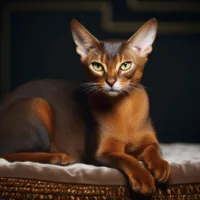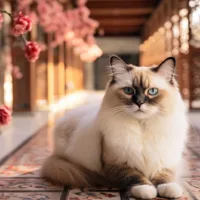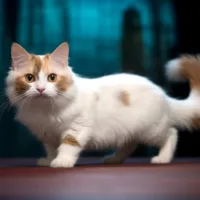Siamese cat look & fur – color-changing cats
The typical coloration that you immediately think of when you hear “Siamese cat” is called “Pointed” – it is created by genetics. Sounds simple at first, but it gets exciting when you imagine the following: This cat breed carries a gene for albinism. Albinism suppresses the formation of pigments in the coat. But a modifier gene, which is also present in the Siamese cat, changes the “expressiveness” of the albinism. This modifier gene works depending on the temperature! The cooler the temperature, the more the albinism gene is suppressed. At birth, Siamese cats are still white because the temperature in the womb was warm enough for the albinism to be fully formed. Later, outside the warm body of the mother, the familiar pattern forms: It is cooler on the legs and nose, as well as on the ears and around the tail, so the albinism slowly recedes there. It can take up to nine months until the coloration of the pattern has reached its finished image. By the way, this also means that a cat with Pointed pattern, which is regularly out in the cold, will darken overall with time!
The partial albinism in Siamese cats results in their characteristic blue eyes due to a pigment production defect. However, not all blue-eyed cats are partial albinos. In other blue-eyed cats, pigment cells may be absent, while Siamese cats have these cells but with a malfunctioning pigment-producing enzyme1.

Although the Siamese bears the original name of the breed, its appearance has evolved over time into a modern variation of it. While the deep blue eyes of the traditional Siamese (Thai cat) sit on slightly rounded heads, the modern Siamese type is found with slanted, almond-shaped eyes and very large ears on a triangular head. Both types have elegant-looking bodies. Their legs and tail are long, with the tail having a pointed end. Often the Siamese cat is confused with the Thai cat, and you may see many pictures of Thais in search engines, although you have searched for Siamese. But at the latest, when you look at pictures of breeders, the doubts about differences between the two should vanish into thin air. Siamese cats are medium-sized cats, but they look slender and long because of their build, limbs, and face shape in combination with the very close-fitting coat.
Grooming requirements for a Siamese cat are rather low due to the short, close-fitting coat with no undercoat. Since cats of this breed love attention, you should still brush them occasionally. However, it is not necessary to comb through the entire coat every day. You will certainly enjoy it, as will your cat because it is a unique experience to see her velvety coat in motion. The short coat, which has hardly any undercoat, is responsible for the Siamese’s love of warmth. Cold, wet environment – no thanks! We, therefore, recommend cozy beds and blankets all year round, but especially in winter your cat will love you for providing her with plush faux fur snuggle places.
Siamese only come in the pattern Colorpoint; Recognized colors include Lilac, Blue, Seal, and Chocolate.
Siamese cat health – risks and issues of this fabulous breed
Siamese cats are prone to cardiovascular disease, mammary tumors (in females), and eye diseases such as progressive retinal atrophy (PRA), in which the retinas of both eyes regress, leading to complete blindness. Breeding cats should be tested for the responsible gene so that the disease is not passed on. The mentioned partial albinism can cause strabismus (squint) and nystagmus (eye tremor).
Not really a disease, but a dangerous behavior, is pica syndrome. Cats with this behavioral disorder chew or eat indigestible things, such as cloth, plastic, or even cables. As you can imagine, this can be life-threatening, causing internal injuries or intestinal obstruction that require urgent treatment. According to studies, Siamese and Burmese cats are more often affected by pica syndrome than other pedigree cats. The reasons for its occurrence are not yet clear, but experts believe that in addition to genetics, the psyche also plays a role. Allegedly, Pica syndrome is more likely to occur in cats with behavioral disorders. Such disorders can be caused by a too-early separation from the mother, or they can arise from stress, loneliness, and chronic boredom.2 With a lot of attention, love, and an exciting way of life, at least the psychological factor can be prevented. For how to achieve this you can get advice from the breeder or a veterinarian.



Siamese cat diet – for a happy and healthy tummy
Like all cats, the representatives of the Siamese cat are anatomically designed to obtain their energy from meat and fat. They are dependent on animal proteins. Thus, their food should contain mostly meat and exclusively animal fats, since nutrients from vegetable fats cannot be absorbed at all. Due to the high activity of this breed, the food must provide a large amount of energy. Very good for this purpose is Dynasty Emperor Ragout. It contains taurine and biotin, so in addition to meeting energy needs, it is excellent for strengthening the heart and eyes of the Siamese cat, who is prone to heart and eye diseases.
Siamese cat character – intelligent, social, and very vocal
If you are looking for a people-oriented, playful, sensitive but also curious and very intelligent cat, with the Siamese cat you’ll hit the nail on the head. What does sensitive mean in a cat? For you as an owner mainly: If you can’t spend the whole day with your Siamese cat, it is advisable to keep her in pairs, because she is very sociable and quickly feels lonely or neglected. This actually goes as far as pathological behavioral problems (see health)! The most important condition for the well-being of your Siamese cat is that you have a lot of time for her, or that she has company from other cats (preferably both).
When considering getting one of these beautiful cats, you should also know that they demand attention, often by meowing loudly and frequently. Siamese cats are considered one of the most talkative cat breeds. More than just meowing, however, many different cooing and chattering sounds from this breed give people the impression that they “chat” all the time. Because of this talkativeness and close bond with her human, the Siamese cat is often called the “dog in a cat’s body”.
Siamese cats are very active and want to be able to move freely and a lot. Several scratching posts or even landscapes along the wall for the cats to climb are ideal for them. You should also plan several play sessions per day to keep your Siamese cat balanced and happy. She has a strong hunting instinct, so the play should be designed accordingly. Since she loves to exercise, a cat-proof balcony or a secured garden is great to allow her freedom of movement and hunting. Even here, however, caution is advised because the Siamese cat cannot tolerate cold weather due to its very short coat, which has no undercoat.
High intelligence and an attentive nature make the Siamese very teachable, making clicker training a rewarding activity for both parties. You can also get your kitty used to a leash early on and take her for walks if you like. Just be aware that many dog owners let their dogs run off-leash and not all dogs listen to commands, which can be dangerous. And, as said, it’s necessary to have good weather conditions.
Siamese cat history – ancient yet modern
For cat breeds with a long history, it is difficult to trace the origin of the breed without gaps. Experts disagree about the exact time when the Siamese breed first appeared. The first written mention of the breed is found in the Tamra Maew manuscript, which is in the possession of the Bangkok National Library. This is a collection of poems about cats, some of the texts of which have been traced back to the 12th century.3 This would make the Siamese the oldest cat breed in the world! Based on the written accounts, it is considered certain that the origin of the Siamese cat is Thailand (formerly Siam, hence the name of this breed).
It is also called temple cat because it is said to have been kept by monks in temples. If we may believe Siamese legends, these cats accompanied the souls of the deceased on their last journey. Even reincarnations of souls into the cats are said to have taken place. It is said that for this purpose a Siamese cat was placed in the grave. When it came out of one of the openings of the tomb, it is said to have absorbed the soul of the deceased. Since the monks treated these cats with much respect and care or even revered them, the belief that one’s soul could live on in such a pampered cat was popular within the royal family. No wonder – when people treat cats appropriately well, it is apt to describe cat life as heavenly!
From the book “Our Cats (…)”, written by Harrison Weir, who is considered a co-founder of modern cat breeding, we know that in 1871 the Siamese cat was in a cat show for the first time, in this case, the Crystal Palace Show. However, there are also numerous references to the cat pair Pho and Mia, but they were not imported from Bangkok to England until more than ten years later, around 1886. It is therefore suspected that the earlier “Siamese” was a different breed after all. Weir nevertheless documented the participation of fifteen cats and four males of the Siamese breed at the Crystal Palace Show between 1871 and 1887.
Breeding Siamese cats turned out to be difficult. Not only were the animals extremely susceptible to worms and the harsh climate, but also the King of Siam allowed males to be exported only exceptionally rarely. The Siamese cat was to be bred exclusively in Siam, where it was considered a royal cat.4
The first Siamese cat in the United States belonged to President Rutherford Hayes. He received it as a gift in 1878 from a diplomat who was working in Thailand.5 Since the 1970s, the “modern” type has also been bred. It is still commonly known as the Siamese but also as the “marten face” or “wedge head” Siamese, while the traditional type is called the Thai or “apple head”.
Suitable for experienced cat owners with large apartment or house and home-office or part-time work
- Experience level: Experienced
- Housing: Large apartment/house
- Activity level: High
- Energy level: High
- Trainability: High
- Attachment: High
- Friendliness: High
- Playfulness: High
- Talkativeness: High
- Intelligence: High








